#evolutionary biology
Text
Not enough people know that vegetables are a human construct
#not the medical kind#Nessie on drugs#biology#evolutionary biology#evolution#science#botany#cooking#cooking advice#cooking tips#vegetarian#vegan#vegetable#vegetables#r/196#196#r/196archive#/r/196#rule#meme#memes#shitpost#shitposting
61 notes
·
View notes
Text

BOW DOWN TO THE ANCIENT ONE
52K notes
·
View notes
Text

31K notes
·
View notes
Text
This just in, starfish are a radially symmetrical head with a stomach.
God I love echinoderms
If you told someone that there’s an entire group of animals that develop butt first as embryos are born bilateral but then grow a radially symmetrical head like a cancer in their side that then bursts out and lives as a completely separate organism from its birth form and moves via hydraulic systems…
They wouldn’t believe you. Yet one of the most beloved cartoon characters is one of them.
#biology#genomics#genome#genomes#genome sequencing#evolutionary biology#echinoderm#starfish#asteroidea#bilateria#Deuterostome#Deuterostomia
5K notes
·
View notes
Text
Fursuit noses getting damaged by people booping them with cameras led to progressively more reinforced noses, and has now culminated in fursuit noses becoming so rugged they can damage camera lenses
This feels like a demonstration of evolutionary pressure
945 notes
·
View notes
Text
Small, shelled, and unassuming, chitons have eyes unlike any other creature in the animal kingdom.
Some of these marine mollusks have thousands of bulbous little peepers embedded in their segmented shells, all with lenses made of a mineral called aragonite. Although tiny and primitive, these sensory organs called ocelli are thought to be capable of true vision, distinguishing shapes as well as light.
Continue Reading.
331 notes
·
View notes
Note
Birds are class Aves.
Sure, under Linnaean taxonomy. But, well,
A) Linnaeus was a eugenecist so his scientific opinions are suspect and his morality is awful
B) he didn't know about evolution
C) he didn't know about prehistoric life
so his classification system? Sucks ass. It doesn't work anymore. It no longer reflects the diversity of life.
Instead, scientists - almost across the board, now - use Clades, or evolutionary relationships. No rankings, no hierarchies, just clades. It allows us to properly place prehistoric life, it removes our reliance on traits (which are almost always arbitrary) in classifying organisms, and allows us to communicate the history of life just by talking about their relationships.
So, for your own edification, here's the full classification of birds as we currently know it, from biggest to smallest:
Biota/Earth-Based Life
Archaeans
Proteoarchaeota
Asgardians (Eukaryomorphans)
Eukaryota (note: Proteobacteria were added to an asgardian Eukaryote to form mitochondria)
Amorphea
Obazoa
Opisthokonts
Holozoa
Filozoa
Choanozoa
Metazoa (Animals)
ParaHoxozoa (Hox genes show up)
Planulozoa
Bilateria (all bilateran animals)
Nephrozoa
Deuterostomia (Deuterostomes)
Chordata (Chordates)
Olfactores
Vertebrata (Vertebrates)
Gnathostomata (Jawed Vertebrates)
Eugnathostomata
Osteichthyes (Bony Vertebrates)
Sarcopterygii (Lobe-Finned Fish)
Rhipidistia
Tetrapodomorpha
Eotetrapodiformes
Elpistostegalia
Stegocephalia
Tetrapoda (Tetrapods)
Reptiliomorpha
Amniota (animals that lay amniotic eggs, or evolved from ones that did)
Sauropsida/Reptilia (reptiles sensu lato)
Eureptilia
Diapsida
Neodiapsida
Sauria (reptiles sensu stricto)
Archelosauria
Archosauromorpha
Crocopoda
Archosauriformes
Eucrocopoda
Crurotarsi
Archosauria
Avemetatarsalia (Bird-line Archosaurs, birds sensu lato)
Ornithodira (Appearance of feathers, warm bloodedness)
Dinosauromorpha
Dinosauriformes
Dracohors
Dinosauria (fully upright posture; All Dinosaurs)
Saurischia (bird like bones & lungs)
Eusaurischia
Theropoda (permanently bipedal group)
Neotheropoda
Averostra
Tetanurae
Orionides
Avetheropoda
Coelurosauria
Tyrannoraptora
Maniraptoromorpha
Neocoelurosauria
Maniraptoriformes (feathered wings on arms)
Maniraptora
Pennaraptora
Paraves (fully sized winges, probable flighted ancestor)
Avialae
Avebrevicauda
Pygostylia (bird tails)
Ornithothoraces
Euornithes (wing configuration like modern birds)
Ornithuromorpha
Ornithurae
Neornithes (modern birds, with fully modern bird beaks)
idk if this was a gotcha, trying to be helpful, or genuine confusion, but here you go.
all of this, ftr, is on wikipedia, and you could have looked it up yourself.
671 notes
·
View notes
Text
My mom bought me this book for Christmas
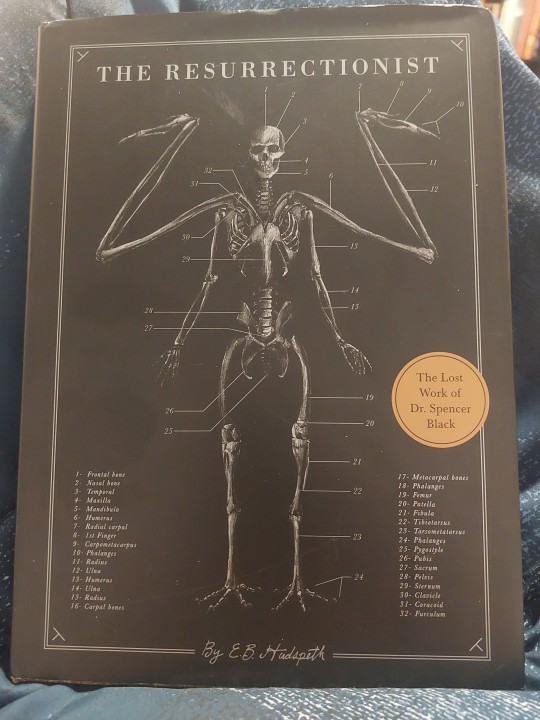
The Resurrectionist by EB Hudspeth, a fantasy field guide full of anatomical illustrations of monsters and cryptids.

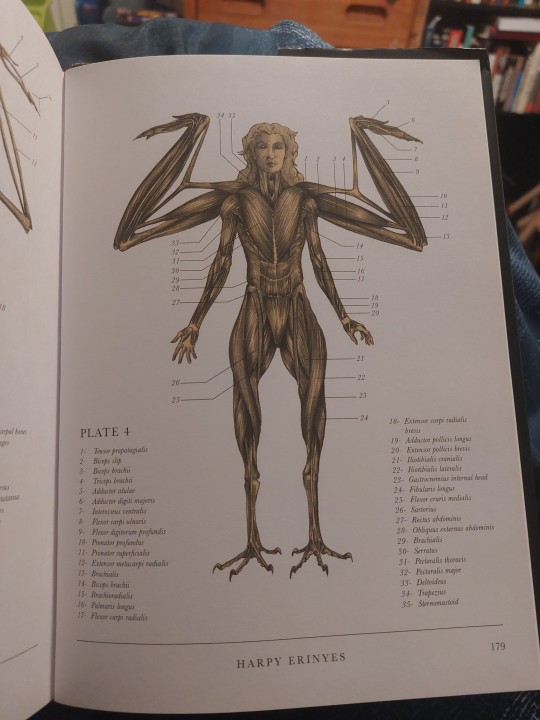
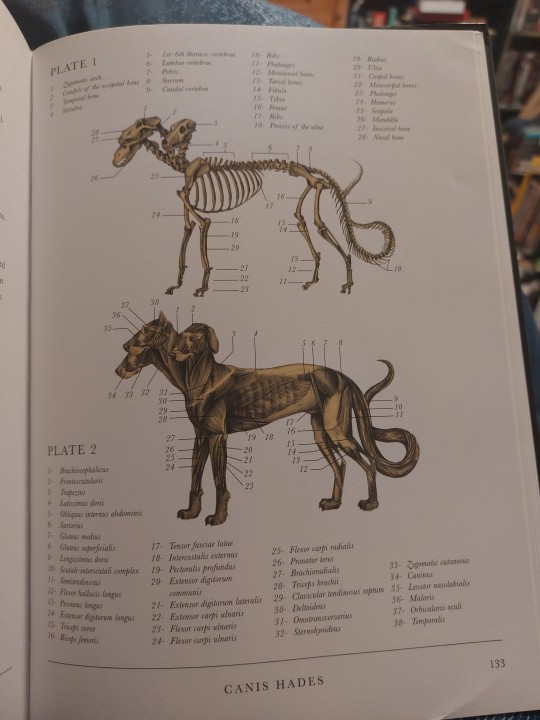

The musculoskeletal systems are fun to look at, but not nearly as in-depth as I would have liked. If you have more than a passing knowledge of taxonomy (or in my case, access to Wikipedia), a lot of the details fall apart under scrutiny
The harpy has four upper limbs connected to one shoulder girdle; it shouldn't have arms, only wings
The sphinx is not classified as a mammal, but is still somehow in the family Felidae with cats (and like the harpy is also drawn with only two girdles despite having six limbs. I will give the author credit for giving the sphinx a keel for the wing muscles to attach to)
It lists the Hindu deity Genesha as a cryptid, which is a no-no.
Cerberus is also explicitly not a mammal, but somehow still a canine (literally in the species Canis with wolves, dogs, and coyotes)
Both mermaids and dragons are listed as members of the order Caudata; the only extant members of Caudata are salamanders, which kinda makes sense for dragons, but not so much for mermaids (also, the author keeps playing it fast and loose with cladistics; both mermaids and dragons are in the same order despite being in different classes, and while dragons are explicitly said to be amphibians, mermaids are given the fictional class mammicthyes, which means mammal-fish. At that point, why not just call mermaids amphibians? Why make up a fake latin hybrid name?)
But what bugs me most of all is the classification of the Minotaur as its own order of mammal when in mythology it is explicitly described as a hybrid of two known species (made possible only by the cruel machinations of the divine, but still)
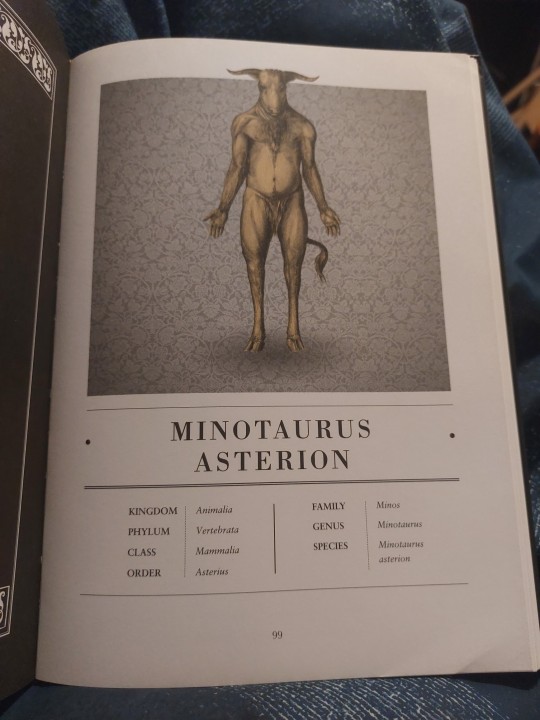
To use actual taxonomical nomenclature, the minotaur's species would be B. taurus × H. sapiens (specifically B. taurus♂ × H. sapiens♀; there are, to my knowledge, no legends of H. sapiens♂ × B. taurus♀). That's how ligers, tigons, mules, zorses, pizzly bears, narlugas, etc., are described.
If I had written this book, I would have leaned more into evolutionary biology. Most land animals have four limbs because they all evolved from boney lobe-finned fish, which split off from the boneless sharks and rays millions of years earlier, so any six-limbed vertebrates would need to be descended from a fictitious category of six-finned fish which would either be an offshoot of boney fish/tetrapods (I guess they'd be hexapods, though that term refers to insect arthropods), OR a precursor to boney and cartilaginous fish that both clades split away from much earlier (it's easier to lose structures than to gain them, so it makes more sense for a six-limbed ancestor to spawn four-limbed descendants than the other way around).
Think about how different elephants are from humans, and humans are from aligators, and aligators are from penguins, and remember that they all evolved from the same ancestor tiktaalik, an amphibious fish that existed some 375 million years ago. Imagine a precursor six-limbed species and how diverse all its descendants would look after 400 million years. Save for the occasional instance of convergent evolution causing two unrelated species to independently evolve similar body plans to fill the same niche, tetrapods and hexapods would look nothing alike. There would be very little recognizable overlap between the two. A six-limbed "pegasus" would not look like a real world horse, and a six-limbed "dragon" would not look reptilian/dinosaur-ish, for much the same reason that giraffes don't look like frogs; they're just too distantly related. Bonless sharks and boney fish and whales/dolphins all have similar looking bodyplans only because their environment requires the same hydrodynamic shape, while terrstrial vertebrates are much more physically diverse.
#biology#anatomy#monsters#cryptids#cryptozoology#book of monsters#evolution#evolutionary biology#evolutionary history#taxonomy#cladistics#science#hard fantasy#hard science fiction#hard science#tetrapod#hexapod
2K notes
·
View notes
Text
hi guyss :) im studying supernatural belief, religious belief, locus of control, and their relationship to evolutionary sex differences for my master's thesis!! i'd grately appreciate if yall can complete and share this survey:
#dark academia#chaotic academia#study motivation#study blog#religion#evolution#supernatural#destiel#human#human history#history#religious trauma#evolutionary biology#evolutionary psychology#evolutionary anthropology#high evolutionary
304 notes
·
View notes
Text
Alpha Males, Sperm competition, and Cuckoldry
(our kinks from an evolutionary biology perspective)

The phenomenon where males experience an increase in desire and fertility when observing their mate engaging with another partner, is often referred to as "sperm competition risk"
From an evolutionary biology perspective, this behavior can be understood through several theories:
Sperm Competition Risk:
Increased Ejaculate Volume: Males typically respond to the perceived risk of sperm competition by greatly increasing the volume of their ejaculate. This is thought to function as a form of displacement, increasing the chances of their sperm outcompeting that of potential rivals.
Increased Sexual Arousal and Fertility:
When males perceive or observe their partner with another mate, particularly when chance of sperm competition exist (other males trying to fertilize the same egg), this triggers an adaptive response in the form of greatly increased sexual arousal, desire and fertility. This is thought to be an adaptation to compete effectively in situations where multiple males are vying for the opportunity to father offspring.
Potential benefits
From an evolutionary perspective, the heightened desire, arousal, focus, and drive provide a large competitive advantage. If there's a chance of sperm competition, being sexually impassioned increases the likelihood of the observing male's sperm fertilizing the egg. The continuous denial of sexual interaction further amplifies these benefits. By maintaining a state of heightened desire without immediate release, the observing male sustains an elevated level of reproductive readiness. This prolonged state of arousal becomes an advantageous strategy, potentially increasing the male's chances of success not only in reproduction but also in various aspects of everyday life. The surplus of energy, focus, and drive may contribute to success across different domains, aligning with the overarching goal of evolutionary fitness.
Cuckoldry Detection and Response:
Adaptive Jealousy:
Evolutionary psychology suggests that males who exhibit jealousy and distress over potential infidelity may have had a reproductive advantage.
This emotional response acts as a mechanism to deter a mate from engaging with other males, reducing the risk of cuckoldry.
The cuckold male may also gather information by observing the mating behaviors of potential rivals. This is thought to be an adaptive strategy to understand the competition and adjust his own behaviors accordingly.
Paternal Investment:
In species where males invest significantly in parenting, there is an evolved response to protect their paternal investment. The greatly Increased arousal along with increased romantic and sexual interest in response to perceived mate infidelity is a strategy to safeguard resources and parental care for their own genetic offspring.
The alpha male typically refers to a dominant and high-status male in a social group. The alpha male generally has preferential access to mates and reproductive opportunities.

Alpha Male Cuckoldry reproductive strategy:
Within the context of cuckoldry, the alpha male strategically reserves exclusive access to mates. Cuckoldry occurs when the non-dominant male knowingly or unknowingly raises offspring that do not carry his genetic material.
This reproductive strategy is advantageous for the both the alpha male and his mate, allowing him to pass on his own genes while minimizing resource-intensive parental duties. The female benefits by mating with a genetically superior male while sharing parental responsibilities with the non-dominant male.
By ensuring that the non-dominant male invests in raising offspring that carry the alpha male's genetic legacy, this reproductive approach aligns with the collective goal of the female and alpha male, maximizing his reproductive success within the social structure. The alpha male's dominance and preferential access to mates become central elements in shaping the dynamics of cuckoldry as an evolutionary strategy.
Often, the non-dominant male, in his role, finds personal satisfaction in having his sexual and reproductive desires denied as he plays a crucial part in perpetuating the genetic lineage of the dominant alpha male rather than his own.
161 notes
·
View notes
Text

I don't know what I'm doing anymore lol. Getting back into paleo stuff. Tiktaalik feelings.
I plan on making this into a small edition of 2 color screen prints on paper, so follow along to get notified for that!
Photoshop // ~ 8 hours
Instagram // X // Bluesky
#paleoart#paleontology#drawing#tiktaalik#screen print#devonian#digital art#photoshop art#green#evolution#evolutionary biology
121 notes
·
View notes
Text
List of Extremely Cursed Knowledge
Having autism and ADHD is a blessing and a curse because on one hand, I’m basically a walking encyclopedia of random facts and information. On the other hand, a fair amount of that information is so fucked up that it’s not socially acceptable to share it with anyone. So naturally, I took every fucked up fact, every bit of twisted trivia, every bit of cursed knowledge that I could come up with off the top of my head and compiled it into one big list to post on the internet. Some of this information may permanently ruin your (you, the reader) perception of certain things. None of this information should have ever seen the light of day, and a fair amount of it was never, ever meant to be known by humans.
You cannot unlearn anything on this list. This is your chance to scroll past.
You have been warned.
\/ \/ \/
According to FDA standards, a jar of peanut butter is allowed to have up to seven (7) rat hairs before it’s considered unfit for human consumption. If it has 7 or less rat hairs it will still be sold in stores.
If I just ruined peanut butter for you, don’t google the FDA regulations on any other foods you enjoy.
Human teeth have 36 calories each.
The average human body has roughly 125,000 calories. This is actually relatively low, which makes cannibalism in humans generally unsustainable.
Human meat tastes like pork.
Penguins have been observed practicing necrophilia.
Dolphin vaginas secrete a substance that acts like an aphrodisiac on steroids. When scientists swabbed some of it on a chimpanzee’s penis, it masturbated so furiously that it had a heart attack and died.
Dolphins have been known to intentionally commit suicide if kept in poor conditions.
Scientists that work with cockroaches often become allergic due to exposure. Simultaneously, they also develop an allergy to chocolate and pre-ground coffee. Make of that what you will.
Dolphins have been observed masturbating using decapitated fish heads.
Dolphins have been observed getting high on pufferfish venom recreationally, sometimes even passing a pufferfish around like a joint.
There’s a LOT of rape across the entire animal kingdom. Like, a LOT. It’s especially prevalent in dolphins, otters, ducks, penguins, and primates, to name a few.
On a related note, female ducks have corkscrew shaped vaginas. Male ducks also have corkscrew shaped penises that measure in at a whopping eighteen inches.
The barnacle has the largest penis to body size ratio in the animal kingdom, with its penis being up to eight times as long as its body.
Chimpanzees have been observed using frogs as a fleshlight.
A disembodied human head weighs about 10-12 lbs and is balanced in such a way that requires you to use both hands to pick up.
Pigs will eat every single part of a corpse - including bones. In 2012 a farmer in Oregon was eaten by his pigs after having a heart attack and falling in their enclosure. This also makes pig pens a prime spot for dumping bodies.
A body will decompose faster if you fill the rectal cavity with yogurt before burying it
When burying a body, make sure to bury it in a heavily wooded area. If vegetation is too sparse and/or the body isn’t buried deep enough, it will be easily noticeable after a few months because plants will grow in much thicker directly above where the body was buried.
You cannot bury a body in sand, as sand is too porous. The smell will seep through and give away the location
The entire universe could theoretically exist as a false vacuum and collapse into nothingness at any moment without warning.
Any alien civilization advanced enough to detect life on earth is also probably advanced enough to destroy our entire planet almost immediately. At the peak of interstellar technology, the only limiting factor is the speed of light. If they decided to attack, we probably wouldn’t even know it was coming until the entire surface of the planet was already vaporized.
It takes three and a half rotations to fully detach a human head from its body.
Recently deceased bodies can experience rigor erectus, which translates to “death boner.” This is especially common in victims of hanging, as it’s primarily caused by trauma to the cerebellum or spinal cord.
There is an extremely real chance that you have unknowingly purchased a product that was made by modern day slaves at least once in your life. Coffee, cotton, fish, clothes, shoes, and technology are among the most vulnerable industries.
A decapitated head remains conscious for several seconds after separated from the body.
The entire koala population across Australia is currently undergoing a major chlamydia epidemic. It’s actually been extremely devastating for them and they’re currently facing the threat of extinction because of it.
#Nessie on drugs#unfun facts#audhd#cursed fact#cursed knowledge#cursed#wtf#biology#evolution#evolutionary biology#penguins#r/196#196#r/196archive#/r/196#rule#meme#memes#shitpost#shitposting#autism#actually audhd#adhd#actually autistic#actually adhd#evil autism#crime#criminology#true crime#fun facts
39 notes
·
View notes
Text
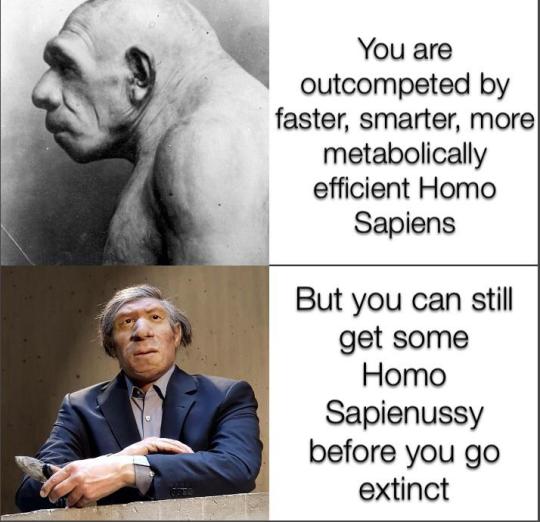
#reddit aint too bad sometimes#anthropology#memes#biology#science#ussy#human history#evolution#human evolution#evolutionary biology#paleoanthropology#paleontology#homo neanderthalensis#neanderthal man#neanderthals#homo sapiens#history
336 notes
·
View notes
Text
The modern world is nice, but sometimes you just get the urge to go primitive. Because I'm a complete wimp who would die within a day of giving up the internet, I'm going to deal with that urge by talking about primitive animals. It's Wet Beast Wednesday and I'm talking about lancelets.

(image: a lancelet. Not much to look at, are they?)
Lancelets, or amphioxi, are highly basal (close to the ancestral form) chordates that are vaguely similar to fish, but are vastly more primitive. They have all the characteristics of chordates, the key one being a notochord, a flexible rodlike structure that goes down the body. The majority of chordates that are still alive are vertebrates, who have incorporated the notochord into the spinal column. The other groups of surviving chordates are the tunicates (who I'll get to eventually) and the lancelets. Because lancelets are so primitive, they are used at model organisms representing an early stage of vertebrate evolution. It was originally thought that lancelets are remnants of an early lineage that eventually evolved into vertebrates. Genetic studies later showed that tunicates are actually more closely related to modern vertebrates than lancelets. They are still used as a model organism as they are a fantastic representation of early chordates. The similarity of lancelets to the 530 million year old Pikaia gracilens, one of the earliest known chordates, is one of the reasons they are such a useful model organism.

(image: a diagram of lancelet anatomy by Wikipedia user Systematicist)
Lancelets can be found all over the world, living in temperate to tropical shallow seas. The only known exception is Asymmetron inferum, which has been found around whale falls at 225 m (738 ft) deep. They are small animals, reaching around 8 cm at their largest. An amphioxus looks pretty worm-like, with a simple mouth at one end and a pointed tail at the other. The name amphioxus means "both (ends) pointed" which is a pretty appropriate description. The mouth is lined with tentacle-like threads called oral cilli, which are used for feeding. Lancelets are filter-feeders that use the cirri to filter plankton, microbes, and organic detritus. Water and food pass into the pharynx (back of the mouth), which is line with gill slits. This is where it gets weird. The gill slits aren't used for respiration, but for feeding. Mucus gets pushed through the gill slits by cilia, trapping the food and moving it deeper into the digestive tract. Not only to lancelets not use their gill slits to respirate, they actually don't have a respiratory system at all. Instead, they just absorb dissolved oxygen through their thin and simple layer of skin. Their circulatory system doesn't move oxygen around either as there is no heart or hemoglobin present. For what it's worth, they don't have a proper live either. When you look at a lancelet's anatomy, you can see similarities to fish anatomy, just much more primitive and with some parts missing.
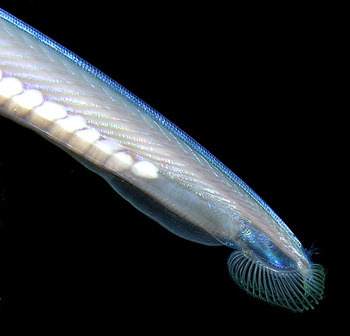
(image: the head of a lancelet, with mouth and cilli visible)
Lancelets have 4 different systems used for vision. Two, the Joseph cells and Hesse organs, are simple photoreceptors that are on the notochord and detect light along the back of the animal. Imagine having a bunch of very simple yes on your spinal cord that can see through your skin. There is also a simple photoreceptor called the lamellar body (which confusingly is also the name of a type of lipid) and a single simple eye on the head. Speaking of light, lancelets are florescent, producing green light when exposed to blue to ultraviolet light. In all species, the proteins responsible for this are found around the cilii and eye, but some species also have them in the gonads and tail. The purpose for this florescence isn't exactly known, but a common hypothesis is that it helps attract plankton toward their mouths.
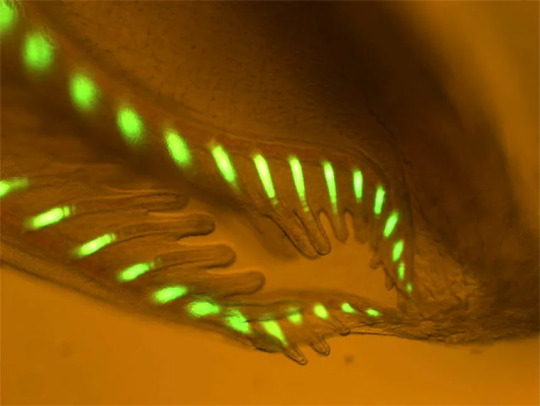
(image: an extreme close-up of a lancelet's cilli fluorescing)
Lancelets have seasonal reproduction cycles that occur in summer. Females release their eggs first, followed my males releasing sperm to fertilize them. Depending on species, spawning can either occur at specific times, or gradually throughout breeding season. Development occurs in several stages. In the frist stage, they live in the substrate, but they will quickly move into the water column to become swimmers. These swimming larvae practice diel vertical migration, traveling to the surface at night and returning to the seafloor in the day. While larvae can swim, they are still subject to the current and can be carried long distances. Adults retain their ability to swim, which is done by wriggling like an eel and in some cases, spinning around in a spiral fashion while moving forward. Unlike the larvae, adults spend most of their time buried in the substrate with only their heads exposed. They typically only emerge when mating or if disturbed.
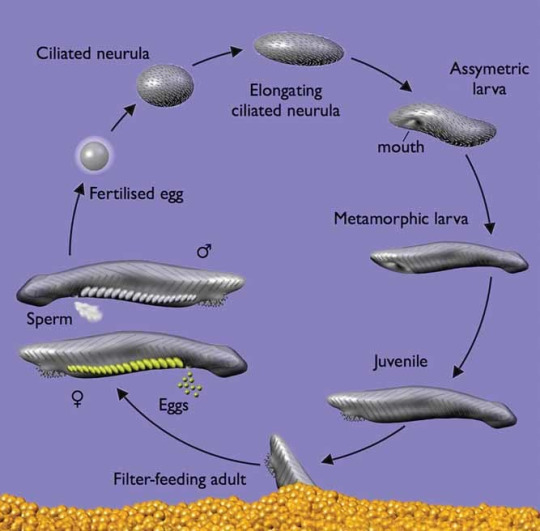
(image: a diagram of the lancelet life cycle. source)
Because of their use as model organisms, humans have developed methods to keep and breed lancelets in captivity. The majority of research has been done on Branchiostoma lanceolatum, but several other species have been studied. Multiple species are endangered due to pollution and global warming. Several species are edible and can either be eaten whole or used as a food additive. In spring, when their gonads begin to develop for breeding season, they develop a bad flavor.
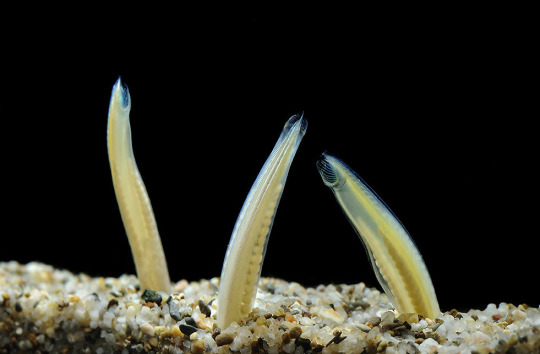
Mom: "we have garden eels at home". Garden eels at home:
(image: three lancelets sticking their heads out of the sediment)
#wet beast wednesday#weird-ass tube beast#lancelet#amphioxus#chordate#chordata#marine biology#biology#ecology#zoology#animal facts#evolutionary biology
232 notes
·
View notes
Text
Phylum #11: Priapulida, the penis worms!

It is the late Ediacaran. For thirty million years, enigmatic creatures have peacefully grazed on microbial mats - unique ecosystems where layers of photosynthetic bacteria covered the shallow seafloor. And then the penis worms arrived.
Priapulids were among the first animals to start digging inside the substrate at a large scale. Unlike previous creatures, their burrows were vertical, not horizontal. Disturbing the microbial mats in depth and oxygenating the substrate, they set the stage for life to diversify in a new ecosystem. The Cambrian substrate revolution had begun.
530 million years later, priapulids - named after the Greek god of fertility - survive as one of the three scalidophoran phyla. The only ones to still reach massive sizes, some species can be up to 40 centimeters long!
While they do not have plated armor or complex spines like their cousins, they share the ability to extend and retract their spiked head. They also live in or near the seafloor, often hunting for sea worms which they catch with their toothed, eversible pharynx. Their body often ends in complex tail appendages, believed to act as gills thanks to their large surface area.

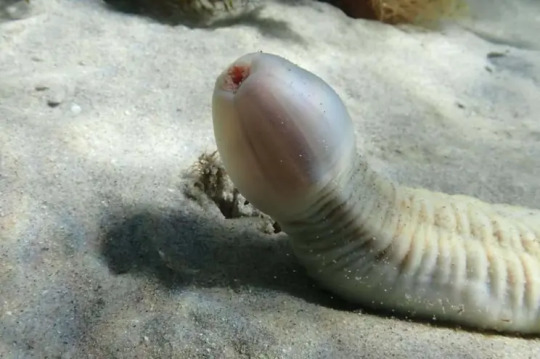
#forms and phyla#priapulida#penis worm#palaeoblr#taxonomy#evolutionary biology#scalidophora#ecdysozoa
323 notes
·
View notes
Text
What of the possibilities that are not adaptive for the system, in part or as a whole
#adamant#urinal puck#janitorial supplies#evolutionary biology#ornithology#paleontology#birds#birds of prey
96 notes
·
View notes